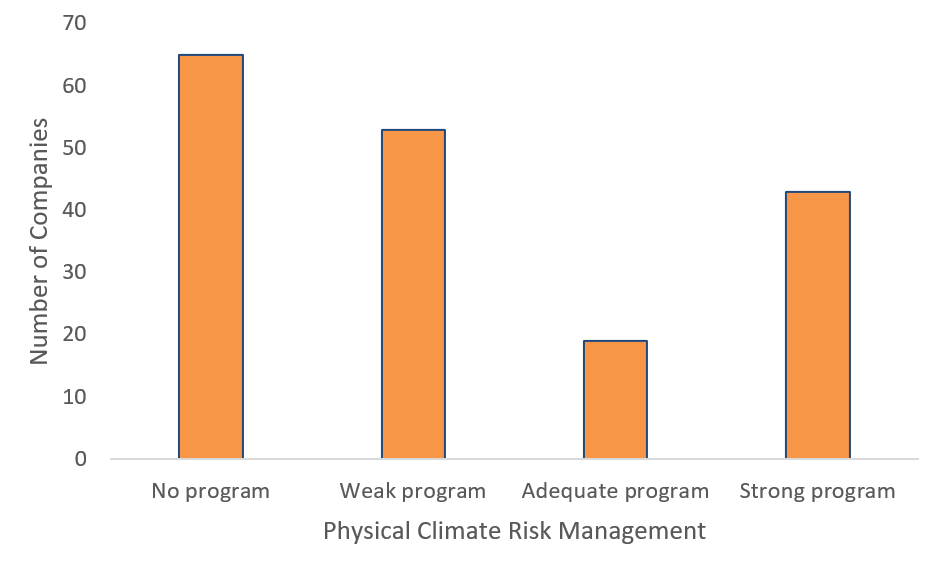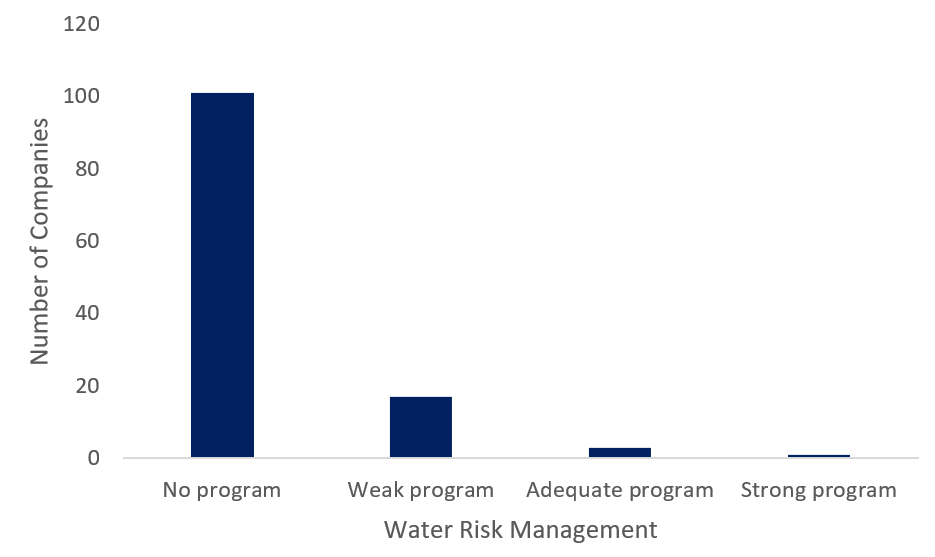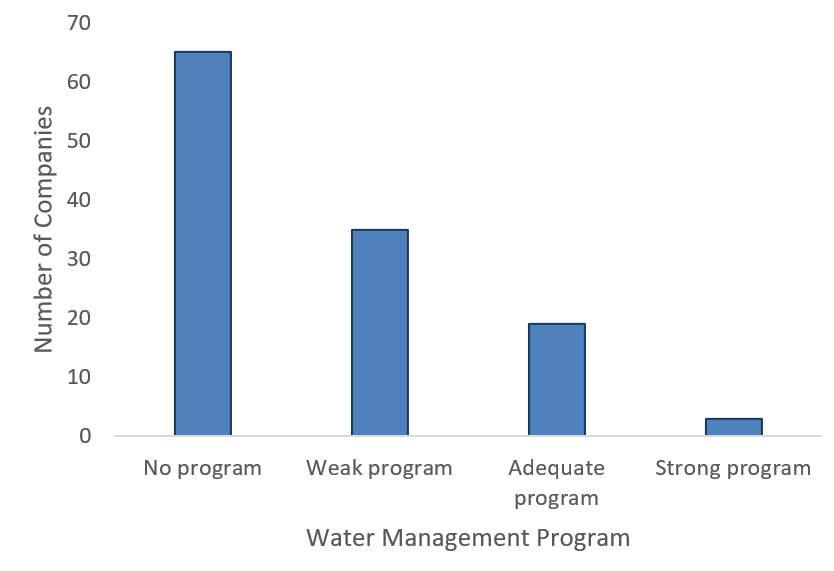Water stress and water scarcity* are growing global issues exacerbated by climate change. Companies whose business models rely on the consistent availability of large volumes of water are exposed to water risks, including water shortages and restrictions that may adversely impact their ability to carry out operations and result in additional costs. Companies that use water-intensive data centers are exposed to such risks. Data centers play a critical role for many technology and telecom companies and for their supporting servers, digital storage equipment and network infrastructure for data processing and storage.i Data centers require high volumes of water directly for cooling purposes and indirectly, through electricity generation.ii Morningstar Sustainalytics’ recent activation of the Resource Use Material ESG Issue (MEI) within its ESG Risk Ratings recognizes water risks of data centers.
This trend is observed in companies that operate data centers in the Internet Software and Services, Data Processing, Enterprise and Infrastructure Software, and Telecommunication Services subindustries.
Morningstar Sustainalytics’ ESG Risk Ratings assesses a company’s exposure to water risks (where applicable) in part through the regional water stress beta indicator. Furthermore, it evaluates a company’s management of Resource Use risks, assessing multiple factors such as its water management program, water risk management, physical climate risk management, water intensity and water intensity trend.
Data Center Water Risks
Data centers are located worldwide, some in water-stressed regions prone to droughts, water shortages and water restrictions, subjecting companies to operational disruptions due to insufficient water resources. The progression of physical climate risks and subsequent growing issue of unpredictable water supply globally could introduce new water regulations, increasing compliance costs for companies and potentially restricting the amount of water they are permitted to use. Additionally, community conflicts over water usage could ensue in water-stressed regions, presenting reputational and operational risks. Recently, some companies operating data centers in the United States, including New Mexico, Arizona, and South Carolina, have faced push-back from local communities and water conservation stakeholders competing for the same water resources.iii,iv In one case, after a two-year feud with a conservation group, a company agreed to use groundwater under limited conditions (e.g. during maintenance work) and instead pay for surface water from the region’s public water utility.iii Engaging with local stakeholders and considering contextual water risks that include, for example, evaluating region-specific water risks prior to building data centers can result in maintaining companies’ social license to operate in the long run, cost savings and competitive advantages over peers. Furthermore, considering water within enterprise risk management, having a strong water management program in place, and investing in water efficiency technologies provide a good indication of whether a company is prepared to mitigate water-related risks.
Water Resource Use Management Analysis
The following analysis is based on water resource use management data for 122 companies in the Enterprise and Infrastructure Software, Data Processing, Internet Software and Services and Telecommunications Services subindustries that operate data centers.
Fig. 1 (Source: Morningstar Sustainalytics)

A greater number of companies disclosed more information on their physical climate risk management than on water risk management, with 64% of companies disclosing elements of a physical climate risk management program (Fig. 1) and only 16% disclosing elements of a water risk management program (Fig. 2). Physical climate risk management within Sustainalytics’ ESG Risk Ratings assesses companies’ preparedness for physical climate change risks. It is broader in scope than water risk management, which focuses on companies’ oversight and initiatives to mitigate the risks posed by water scarcity. For example, water risk management within the ESG Risk Ratings assesses whether a company integrates water scarcity into regular risk assessments and its business strategy. The higher prominence of climate-related reporting frameworks such as the Task Force on Climate-Related Financial Disclosures (TCFD) along with growing regulatory scrutiny of companies’ GHG emissions may contribute to companies providing greater disclosure on physical climate change management than water risk management, which currently has not received as much attention. As awareness of water risks and their importance increases, we expect to see more water-related disclosure from companies.
Fig. 2 (Source: Morningstar Sustainalytics) Fig. 3 (Source: Morningstar Sustainalytics)


Nearly half of companies disclosed elements of a formal water management program (Fig. 3); of those that had disclosure, 61% were rated as having a weak program, 33% an adequate program and 5% a strong program. This management indicator assesses factors such as whether a company has initiatives to reduce freshwater use, water reduction targets and deadlines, and monitors and measures their water use. The majority of companies (84%) did not disclose the necessary data (such as water withdrawal or water consumption) to calculate their water intensity; as a result, it was not possible to calculate and benchmark their water intensity against peers.
Microsoft – an example of best practices in water disclosure and management
Microsoft is the only company in our analysis to receive top scores for its water risk management and water management program. Its water intensity also showed a significant decrease compared to its three-year average. Microsoft’s success is attributed to its investment in becoming water positive by 2030.v It has applied new technologies in its data centers, like the Smart Water Navigatorvi and adiabatic cooling, a technology that uses outside air instead of water for cooling, when temperatures are below 85 degrees Fahrenheit.vii
* Water scarcity: the volumetric abundance, or lack thereof, of freshwater resources [that accounts only for availability, or volumetric supply vs. demand].
Water stress: the ability, or lack thereof, to meet human and ecological demand for fresh water. Compared to water scarcity, water stress is a more inclusive and broader concept [that accounts for availability, accessibility, and water quality].
Sources
i. Siddik, M., Shehabi, A. and Marston, L. (2021). “The environmental footprint of data centers in the United States,” Environmental Research Letters, accessed (25.05.22) at: https://iopscience.iop.org/article/10.1088/1748-9326/abfba1/pdf
ii. Mytton, D. (2021). “Data centre water consumption,” npj Clean Water, access (25.05.22) at: https://doi.org/10.1038/s41545-021-00101-w
iii. Solon, O. (2021). “Drought-stricken communities push back against data centers,” NBCNews, access (25.05.22) at: https://www.nbcnews.com/tech/internet/drought-stricken-communities-push-back-against-data-centers-n1271344.
iv. Davis, T. (2021), “Facebook Data Center Water Use Scrutinized,”Albuquerque Journal, access (21.07.22) at: https://www.abqjournal.com/2369572/facebook-data-center-water-use-scrutinized.html .
v. Brad Smith (2020), “Microsoft will replenish more water than it consumes by 2030” Microsoft blog, access (10.08.22) at https://blogs.microsoft.com/blog/2020/09/21/microsoft-will-replenish-more-water-than-it-consumes-by-2030/
vi. Microsoft 2021 Environmental Sustainability Report, access (29.07.22) at: https://query.prod.cms.rt.microsoft.com/cms/api/am/binary/RE4RwfV.
vii. https://azure.microsoft.com/en-ca/blog/expanding-cloud-services-microsoft-launches-its-sustainable-datacenter-region-in-arizona/
Recent Content
The Corporate Sustainability Due Diligence Directive: A Step Towards Stronger Human Rights and Environmental Practice
In this overview, discover the key elements of the Corporate Sustainability Due Diligence Directive and what this EU regulation means for addressing social and environmental issues supply chains.
The Stockholm Stewardship Roundtable: A Practitioner’s Notes on Managing Investor Engagement Today
As concerns about greenwashing grow, investors focus on ensuring their portfolio companies uphold sustainability pledges and generate long-term value. Active ownership through strategic engagement is pivotal in driving sustainable practices.





